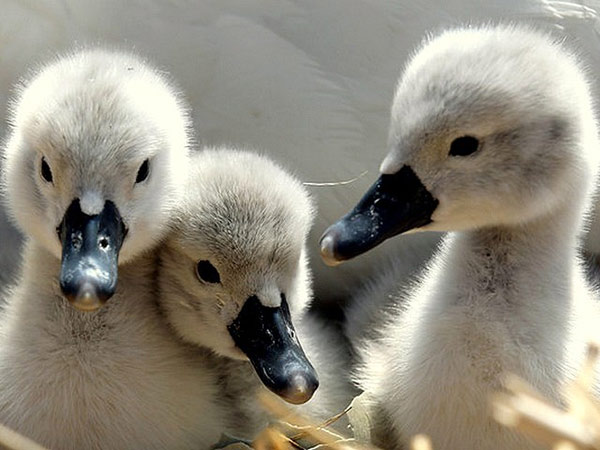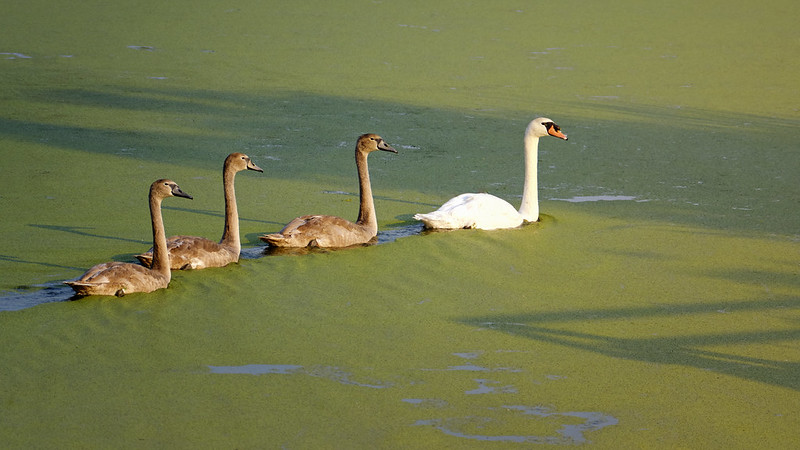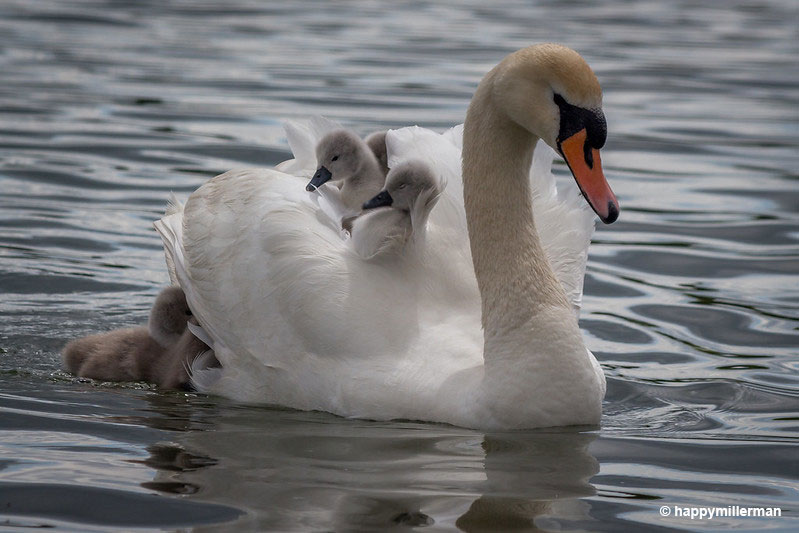
Baby swans are called cygnets and these miniature versions of regal swans, with their fluffy feathers and curious nature give their best to mimic the grace and poise of their parents never fail to captivate the hearts of onlookers.
However, be careful, their parents can be very protective and aren’t afraid to chase you away!
Read on to discover more about them!
On this page
Nest
Swans mate for life and often use the same nest site every year. The male chooses the spot, but the female can reject it until he finds a favorable one. The pair builds the nest together. The male usually collects most of the material, whereas the female constructs it.
The nests are typically built close to lakes and rivers that have calm or still water and in places that have camouflaging vegetation around them.
They are large, circular mounds with some species’ nests reaching a diameter of 11 feet!
The pair builds it from various materials such as branches and twigs, reeds, and other aquatic vegetation. It is a large but neat construction.
Swans have only one brood, but they lay a large clutch of 4-10 eggs with the expectation that some will be lost. Around 50% of swan cygnets do not make it. The eggs are very large, ranging from 4-5 inches in length and 2.4-3.2 inches in width. They are usually white, some species have bluish-gray eggs, and have a bit rough texture.
The mother bird incubates the eggs for 35-41 days while the father swims nearby and wards off predators and intruders. The swan babies stay in the nest for only a week and do test swims, possibly within the first day!
Young swans stay with their parents for 4-5 months, and not uncommonly up to a year. They’re reliant on them for protection, but they forage for their own food, with their parents guiding them.
A swan baby imprints on the first large moving creature that it comes into contact with, most often its mother, and follows her and her commands endlessly.
What Do Baby Swans Look Like
It’s worth mentioning that all swan cygnets look similar, and they’re very hard to tell apart. The certain way to tell apart Mute Swan, Tundra Swan, and Trumpeter Swan babies, is to take a look at their parents.
Baby swans are covered in thick light gray and whitish down. They have a gray-black bill and small black feet.
Baby swans are the largest of the waterfowl babies, being approximately 8 inches long and weighing 8-9 ounces.
They are able to fly within 3-4 months after hatching, although their first flights are short and most often across the water.
Juvenile swans have an overall gray plumage with some brownish patches that become lighter and lighter as they reach the 1-year mark.
After one year, they start becoming white, although they still have some gray feathers. They get their full white plumage during the second summer.

Photograph © _Veit_
What Kind of Food Do Baby Swans Eat?
Swan babies don’t eat for around a week after hatching and this is because they absorb a lot of the yolk in their egg in the hatching process.
Baby swans obtain strongly concentrated nutrients from the yolk, and their survival is affected by how much of it they absorb.
After the first week, they will start to feed themselves, sifting through water in search of microscopic organisms and soft aquatic foliage. Their mother leads them to feeding spots where they will learn to forage for food.
Related: What do baby birds eat?
In their first weeks, the cygnets are not capable of dipping their head below the water, so they only feed on what is on or near the surface.
The parents don’t feed them directly but help by pulling up vegetation and leaving it to float on the surface, or by kicking up food-rich debris from the bottom of the body of water. The latter only works if they’re in shallow water. As they develop, you can see the cygnets mimicking this behavior.
The baby swans feed on soft aquatic foliage, like duckweed, but also on invertebrates.
Frequently Asked Questions About Baby Swans
What is a baby/young swan called?
Young swan and swan babies are called cygnets until they reach their first year of age.
How many cygnets do swans have?
Swans lay 6-10 eggs, but only about 50% of the cygnets survive.
At what age do baby swans turn white?
Baby swans are almost all white by the time they get a year old, but it takes another year for them to turn completely white.
How long do baby swans stay with parents?
Baby swans stay with their parents for 4-5 months, although they are known to stay even longer, up to a year.
Conclusion
In conclusion, baby swans are miniature versions of their regal parents. Their fluffy gray appearance and curious nature make them a cute sight. Swans mate for life and frequent the same nest sites every year.
The nest is large, circular, and built close to the water. Only 50% of swan cygnets survive, as they face numerous threats and predators, and they rely on their parents for protection and help with foraging soft aquatic foliage and invertebrates.

